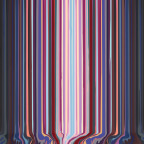Biography
This summer Waddington Custot Galleries present Ian Davenport: Colourfall. Featuring recent paintings as well as examples from the last 25 years, this exhibition is timed to coincide with the publication of a major monograph on the artist’s work by Thames & Hudson.
With influences ranging from European and American abstraction and the music of John Cage to his own urban environment, Davenport's manipulation of paint has earned widespread acclaim since his graduation in 1988. From his early investigations into chance and painting surfaces, to the complex rhythms of his vertically lined colour pieces, Davenport's unconventional methods are unified by intuitive understanding and mastery of the medium.
Ian Davenport studied Fine Art at London's Goldsmiths College of Art. In the summer of 1988, Davenport was one of sixteen artists to exhibit in the famed group show Freeze. This seminal exhibition curated by Damien Hirst introduced the art world to a new generation of artists, a group that would soon become known as the YBAs (Young British Artists). This early exposure led to his inclusion in the 1990 British Art Show and his first solo show at Waddington Galleries.
Just one year later he became the youngest Turner Prize nominee. Davenport has since won international recognition with over forty solo shows across Europe and the USA. His major commissions include Poured Lines: Southwark Street (2006) in London, which is one of the largest permanent public artworks in the UK.
The earliest work included in this exhibition is the monumental painting Satin Black on White from the Bottom to the Top (1989). The work was created with a nail attached to the end of a long stick, a technique which is both a practical way to trail the paint across the canvas and a deliberate subversion of accepted artistic practice. The title is a witty reference to artistic success.
Davenport's richly coloured later work demonstrates a keen receptivity to urban detail. Poured Painting: Magenta, Orange, Magenta (1999), for example, resembles vast architectural arch shapes. Formed by pouring pools of paint into enormous drips and using high-gloss paints, the paintings have a smooth reflective surface that contrasts with Davenport's distinctive handmade approach. In Untitled Circle Painting: Blue, Black, Blue (2005), the artist developed a technique of flipping a work to create repeated round forms and in this series he delicately balances both artistic and engineering ingenuity.
-
 Ian Davenport, Second Season Part 2, 2014
acrylic on stainless steel, mounted on aluminium panels
248.5 x 248.5 cm (2 panels)
%3Cdiv%20class%3D%22artist%22%3E%3Cspan%20class%3D%22artist%22%3E%3Cstrong%3EIan%20Davenport%3C/strong%3E%3C/span%3E%3C/div%3E%0D%3Cdiv%20class%3D%22title%22%3E%3Cem%3ESecond%20Season%20Part%202%3C/em%3E%2C%202014%3C/div%3E%0D%3Cdiv%20class%3D%22medium%22%3Eacrylic%20on%20stainless%20steel%2C%20mounted%20on%20aluminium%20panels%3C/div%3E%0D%3Cdiv%20class%3D%22dimensions%22%3E248.5%20x%20248.5%20cm%20%282%20panels%29%3C/div%3E
Ian Davenport, Second Season Part 2, 2014
acrylic on stainless steel, mounted on aluminium panels
248.5 x 248.5 cm (2 panels)
%3Cdiv%20class%3D%22artist%22%3E%3Cspan%20class%3D%22artist%22%3E%3Cstrong%3EIan%20Davenport%3C/strong%3E%3C/span%3E%3C/div%3E%0D%3Cdiv%20class%3D%22title%22%3E%3Cem%3ESecond%20Season%20Part%202%3C/em%3E%2C%202014%3C/div%3E%0D%3Cdiv%20class%3D%22medium%22%3Eacrylic%20on%20stainless%20steel%2C%20mounted%20on%20aluminium%20panels%3C/div%3E%0D%3Cdiv%20class%3D%22dimensions%22%3E248.5%20x%20248.5%20cm%20%282%20panels%29%3C/div%3E -
 Ian Davenport, Satin Black on White from the Bottom to the Top, 1989
household paint on canvas
102 x 102 in / 259.1 x 259.1 cm
%3Cdiv%20class%3D%22artist%22%3E%3Cstrong%3EIan%20Davenport%3C/strong%3E%3C/div%3E%0D%3Cdiv%20class%3D%22title%22%3E%3Cem%3ESatin%20Black%20on%20White%20from%20the%20Bottom%20to%20the%20Top%3C/em%3E%2C%201989%3C/div%3E%0D%3Cdiv%20class%3D%22medium%22%3Ehousehold%20paint%20on%20canvas%3C/div%3E%0D%3Cdiv%20class%3D%22dimensions%22%3E102%20x%20102%20in%20/%20259.1%20x%20259.1%20cm%3C/div%3E
Ian Davenport, Satin Black on White from the Bottom to the Top, 1989
household paint on canvas
102 x 102 in / 259.1 x 259.1 cm
%3Cdiv%20class%3D%22artist%22%3E%3Cstrong%3EIan%20Davenport%3C/strong%3E%3C/div%3E%0D%3Cdiv%20class%3D%22title%22%3E%3Cem%3ESatin%20Black%20on%20White%20from%20the%20Bottom%20to%20the%20Top%3C/em%3E%2C%201989%3C/div%3E%0D%3Cdiv%20class%3D%22medium%22%3Ehousehold%20paint%20on%20canvas%3C/div%3E%0D%3Cdiv%20class%3D%22dimensions%22%3E102%20x%20102%20in%20/%20259.1%20x%20259.1%20cm%3C/div%3E











